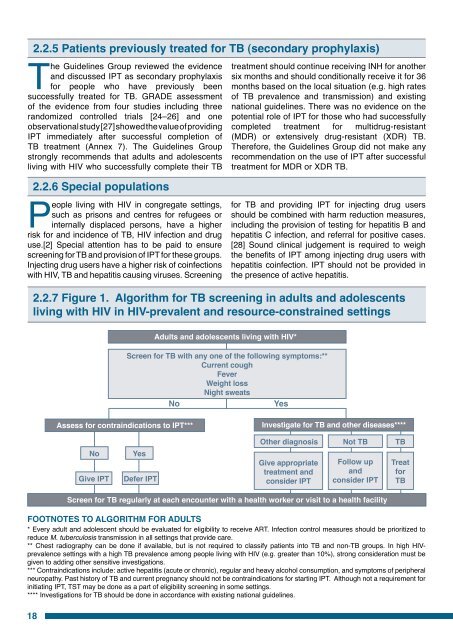Guidelines for intensified tuberculosis case-finding and isoniazid ...
Guidelines for intensified tuberculosis case-finding and isoniazid ...
Guidelines for intensified tuberculosis case-finding and isoniazid ...
Create successful ePaper yourself
Turn your PDF publications into a flip-book with our unique Google optimized e-Paper software.
2.2.5 Patients previously treated <strong>for</strong> TB (secondary prophylaxis)The <strong>Guidelines</strong> Group reviewed the evidence<strong>and</strong> discussed IPT as secondary prophylaxis<strong>for</strong> people who have previously beensuccessfully treated <strong>for</strong> TB. GRADE assessmentof the evidence from four studies including threer<strong>and</strong>omized controlled trials [24–26] <strong>and</strong> oneobservational study [27] showed the value of providingIPT immediately after successful completion ofTB treatment (Annex 7). The <strong>Guidelines</strong> Groupstrongly recommends that adults <strong>and</strong> adolescentsliving with HIV who successfully complete their TBtreatment should continue receiving INH <strong>for</strong> anothersix months <strong>and</strong> should conditionally receive it <strong>for</strong> 36months based on the local situation (e.g. high ratesof TB prevalence <strong>and</strong> transmission) <strong>and</strong> existingnational guidelines. There was no evidence on thepotential role of IPT <strong>for</strong> those who had successfullycompleted treatment <strong>for</strong> multidrug-resistant(MDR) or extensively drug-resistant (XDR) TB.There<strong>for</strong>e, the <strong>Guidelines</strong> Group did not make anyrecommendation on the use of IPT after successfultreatment <strong>for</strong> MDR or XDR TB.2.2.6 Special populationsPeople living with HIV in congregate settings,such as prisons <strong>and</strong> centres <strong>for</strong> refugees orinternally displaced persons, have a higherrisk <strong>for</strong> <strong>and</strong> incidence of TB, HIV infection <strong>and</strong> druguse.[2] Special attention has to be paid to ensurescreening <strong>for</strong> TB <strong>and</strong> provision of IPT <strong>for</strong> these groups.Injecting drug users have a higher risk of coinfectionswith HIV, TB <strong>and</strong> hepatitis causing viruses. Screening<strong>for</strong> TB <strong>and</strong> providing IPT <strong>for</strong> injecting drug usersshould be combined with harm reduction measures,including the provision of testing <strong>for</strong> hepatitis B <strong>and</strong>hepatitis C infection, <strong>and</strong> referral <strong>for</strong> positive <strong>case</strong>s.[28] Sound clinical judgement is required to weighthe benefits of IPT among injecting drug users withhepatitis coinfection. IPT should not be provided inthe presence of active hepatitis.2.2.7 Figure 1. Algorithm <strong>for</strong> TB screening in adults <strong>and</strong> adolescentsliving with HIV in HIV-prevalent <strong>and</strong> resource-constrained settingsAdults <strong>and</strong> adolescents living with HIV*Screen <strong>for</strong> TB with any one of the following symptoms:**Current coughFeverWeight lossNight sweatsNoYesAssess <strong>for</strong> contraindications to IPT***Investigate <strong>for</strong> TB <strong>and</strong> other diseases****NoGive IPTYesDefer IPTOther diagnosisGive appropriatetreatment <strong>and</strong>consider IPTNot TBFollow up<strong>and</strong>consider IPTTBTreat<strong>for</strong>TBScreen <strong>for</strong> TB regularly at each encounter with a health worker or visit to a health facilityFootnotes to algorithm <strong>for</strong> adults* Every adult <strong>and</strong> adolescent should be evaluated <strong>for</strong> eligibility to receive ART. Infection control measures should be prioritized toreduce M. <strong>tuberculosis</strong> transmission in all settings that provide care.** Chest radiography can be done if available, but is not required to classify patients into TB <strong>and</strong> non-TB groups. In high HIVprevalencesettings with a high TB prevalence among people living with HIV (e.g. greater than 10%), strong consideration must begiven to adding other sensitive investigations.*** Contraindications include: active hepatitis (acute or chronic), regular <strong>and</strong> heavy alcohol consumption, <strong>and</strong> symptoms of peripheralneuropathy. Past history of TB <strong>and</strong> current pregnancy should not be contraindications <strong>for</strong> starting IPT. Although not a requirement <strong>for</strong>initiating IPT, TST may be done as a part of eligibility screening in some settings.**** Investigations <strong>for</strong> TB should be done in accordance with existing national guidelines.18















